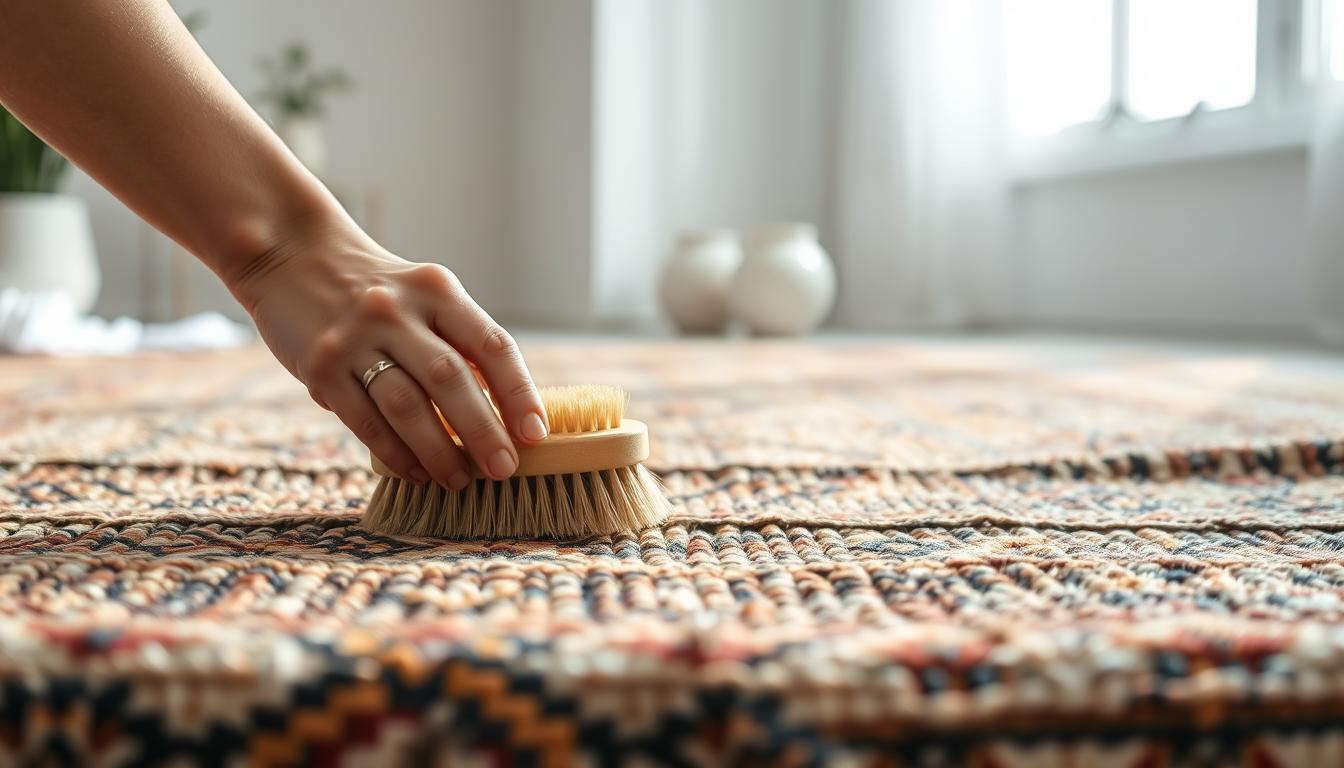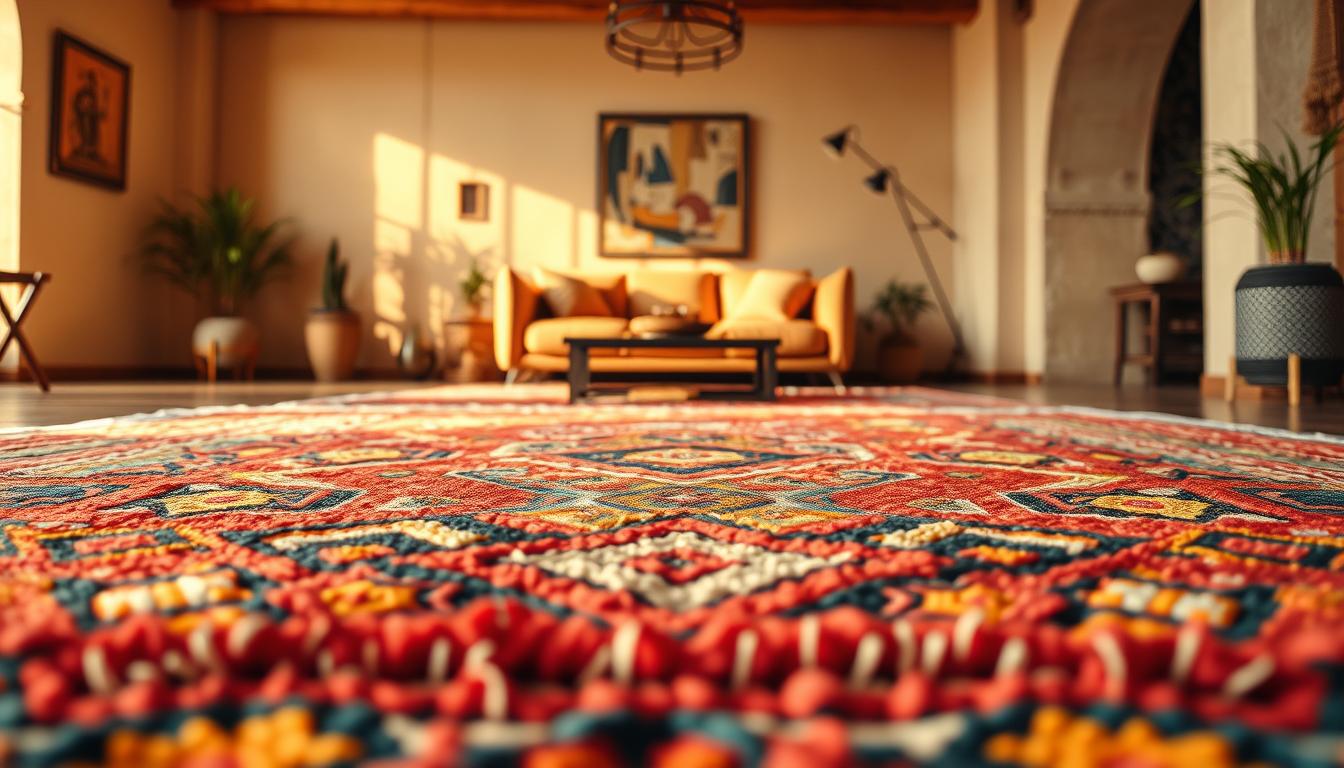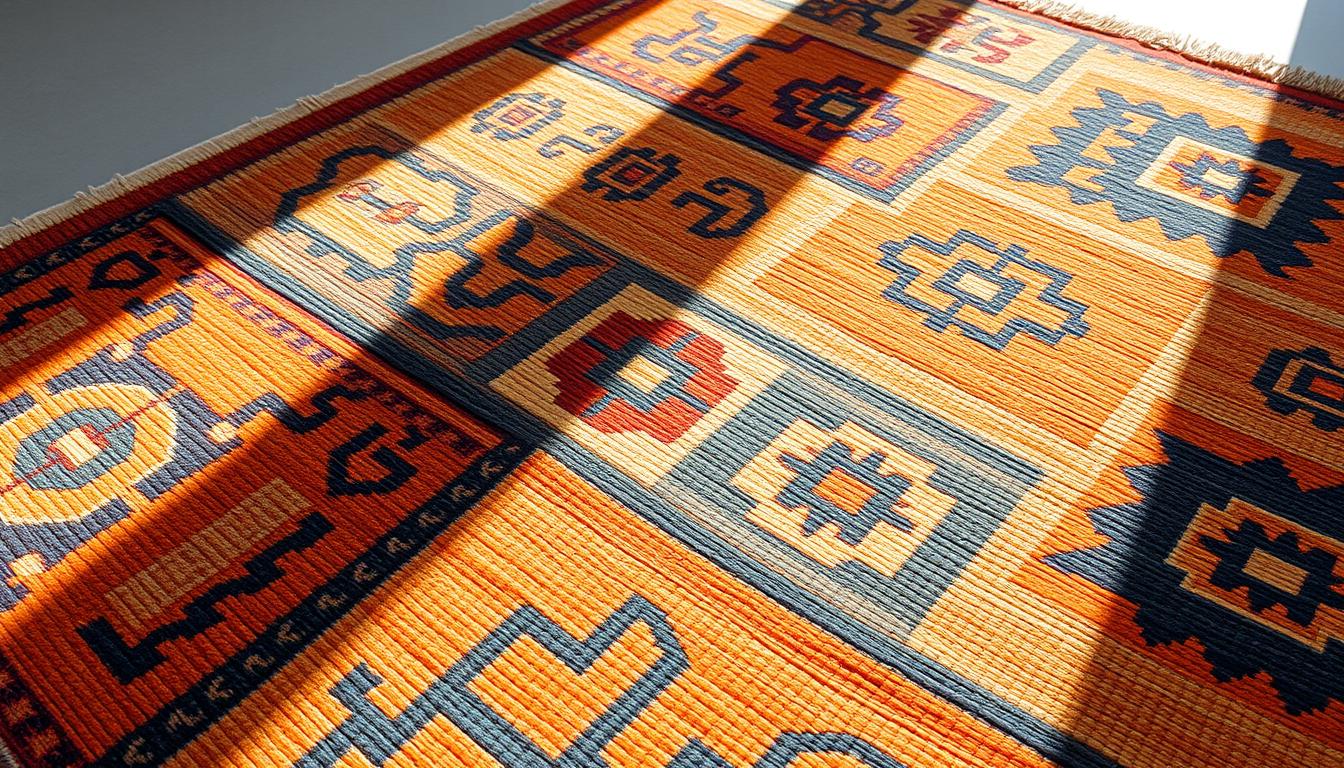
Moroccan Rug Smell: 5 Trusted Ways to Remove Odor
What if your most cherished home decor item starts emitting an unwelcome odor?
Handcrafted textiles carry stories of tradition and artistry, but even these treasures can lose their freshness over time. Understanding how to revive them requires care tailored to their unique materials and cultural value.

Natural fibers like wool absorb moisture and particles deeply, trapping smells that resist ordinary cleaning. Pet accidents, humidity, or dust buildup often cause these issues. Harsh chemicals risk damaging delicate dyes and textures, so gentler solutions are essential.
This guide focuses on methods that respect the craftsmanship of handwoven pieces. You’ll learn to identify odor sources and apply targeted treatments without compromising quality. From sun-drying techniques to specialized solutions, each step prioritizes preservation.
Key Takeaways
- Tailor odor removal to natural fiber types to avoid damage
- Address root causes like trapped moisture or bacteria
- Combine traditional and modern cleaning approaches
- Prevent future odors through proper maintenance
- Use pH-balanced solutions for lasting freshness
Introduction to Moroccan Rug Care and Odor Challenges
Handwoven treasures carry more than beauty—they hold generations of stories in their fibers. The intricate patterns of Berber and Arab craftsmanship demand thoughtful maintenance to protect their legacy. Without proper care, these pieces can develop stubborn odors that threaten their lifespan.
Why Traditional Weaving Requires Special Attention
Thick piles and tight knots in handcrafted textiles create hidden pockets where odors settle. Dust and microscopic particles cling to natural wool, feeding bacteria that produce unpleasant smells. Unlike machine-made alternatives, these pieces absorb moisture deeply, requiring targeted cleaning strategies.
How Odors Affect Your Textile’s Future
Ignoring trapped smells does more than affect your room’s freshness—it risks permanent damage. Moisture retention weakens fibers over time, while microbial growth can fade vibrant dyes. Our specialized cleaning guide shows how to address issues without harming delicate materials.
Proper maintenance preserves both the visual appeal and structural strength of cultural heirlooms. Gentle methods balance modern hygiene needs with respect for artisanal techniques, ensuring these pieces remain functional for decades.
Importance of Regular Maintenance for Moroccan Rugs
Textiles woven with natural fibers thrive when cared for like living materials. Daily attention prevents minor issues from becoming permanent problems, preserving both functionality and artistic value.

Smart Cleaning Routines Save Time
Start with quick daily vacuuming using a brushless head. This removes surface grit before it grinds into fibers. Focus on high-traffic zones where dirt accumulates fastest.
Once monthly, take your piece outdoors for gentle shaking. This simple act dislodges hidden particles modern vacuums might miss. Rotate the textile quarterly to distribute wear evenly – areas under furniture need recovery time too.
Spot-check spills immediately. Blot liquids with white cloths to prevent dye transfer. For solid debris, use dull knives to lift matter without spreading stains. Our step-by-step cleaning guide shows how to tackle accidents before they set.
"Preventative care costs 75% less than restoring neglected textiles" – Textile Conservation Institute
Combine these habits with professional deep cleaning every 2-4 years. High-use spaces may need expert attention sooner. Consistent maintenance keeps fibers resilient, ensuring your piece remains both beautiful and functional for generations.
Trusted Techniques to Remove Moroccan rug smell
Choosing the right approach for refreshing heritage textiles balances effectiveness with material preservation. Gentle solutions often outperform aggressive treatments, especially when dealing with delicate fibers and dyes.
Balancing Nature and Science
Natural remedies work with textile properties rather than against them. Lavender flowers, for instance, release aromatic oils that break down odor molecules. Spread dried blossoms evenly, fold the piece, and let sit 48 hours before vacuuming.
| Method | Effectiveness | Safety | Cost | Best For |
|---|---|---|---|---|
| Baking Soda | Absorbs odors | Non-toxic | $ | Mild smells |
| White Vinegar | Kills bacteria | Color-safe | $ | Pet odors |
| Chemical Sprays | Strong action | Risk of damage | $$$ | Severe cases |
Baking soda acts like a sponge for unwanted scents. Sprinkle it lightly, let sit overnight, then vacuum thoroughly. For stubborn issues, mix equal parts water and vinegar in a spray bottle. Mist lightly and air-dry completely.
Chemical cleaners should be last-resort options. Many leave harsh residues that accelerate fiber breakdown. If commercial products become necessary, test them first on hidden areas. Our cleaning guide explains how to layer natural methods for maximum impact without risks.
Step-by-Step Guide to Cleaning Your Moroccan Rug
How do you maintain freshness in cherished decor without compromising its integrity? Proper care combines strategic techniques with respect for delicate craftsmanship. Follow this sequence to refresh your piece while preserving its cultural value.

Surface Care Essentials
Start with a brushless vacuum cleaner to protect woven patterns. Use the handheld attachment on low suction, moving parallel to the weave. Avoid rotating brushes that could unravel knots.
Take your textile outside monthly. Gentle shaking dislodges hidden debris better than indoor methods. Lay it flat over a clean surface, then flip to address both sides.
Tackling Spills Strategically
Blot liquid spills immediately with white microfiber cloths. Press—don’t rub—to prevent dye migration. For solids, lift edges carefully with a dull knife.
Test cleaning solutions on hidden corners first. Mix 1 tsp mild detergent with 2 cups cool water for most stains. Apply sparingly using blotting motions, then rinse with damp cloths.
"Proper technique extends textile lifespan by 40% compared to harsh scrubbing" – Fiber Arts Preservation Society
Rotate your piece quarterly to distribute wear. Combine these steps with seasonal deep cleaning for lasting vibrancy. Consistent care keeps heirloom-quality items fresh for decades.
Natural Remedies and Home Solutions
Your living space deserves freshness without harsh chemicals. Simple ingredients from your pantry can revive textiles while preserving their delicate fibers. Let’s explore three proven methods that balance effectiveness with material safety.
Harnessing Everyday Ingredients
Baking soda acts like a sponge for unwanted scents. Sprinkle it evenly across the surface and let sit overnight. Vacuum thoroughly in the morning—trapped odors disappear with the powder.
For tougher issues like pet accidents, mix equal parts water and vinegar. Lightly mist the area and air-dry completely. The acidic solution neutralizes bacteria without bleaching dyes.
| Method | Preparation | Action Time | Best For | Safety |
|---|---|---|---|---|
| Lavender Flowers | Spread dry blossoms | 1-2 days | General freshness | Non-toxic |
| Baking Soda | Sprinkle & vacuum | 8-12 hours | Mild odors | Kid-friendly |
| Vinegar Spray | 1:1 water ratio | 4-6 hours | Stubborn stains | Color-safe |
Lavender offers aromatic power. Fold your textile after spreading flowers, then let sit undisturbed for 48 hours. Natural oils penetrate fibers, leaving subtle fragrance instead of chemical residues.
These home approaches cost 80% less than professional services. Combine them seasonally for textiles that stay fresh year-round. Gentle care protects both your decor and indoor air quality.
Deep Cleaning and Professional Care Recommendations
Your treasured decor deserves more than surface-level care. Over time, even well-maintained textiles accumulate particles that demand advanced solutions. Professional cleaning every 2-4 years revitalizes fibers while respecting their cultural significance.
Spotting the Signs for Expert Intervention
Persistent odors after multiple home treatments signal deeper issues. Stains resisting DIY methods or visible fiber damage also indicate it’s time for professional help. Specialists use pH-balanced detergents and controlled drying environments to prevent shrinkage.
Expert services involve three stages:
- Mechanical dusting to remove embedded particles
- Hand-washing with heritage-safe solutions
- Protective treatments that repel future stains
| Method | Frequency | Tools | Best For | Safety |
|---|---|---|---|---|
| Professional Cleaning | 2-4 years | Specialized extractors | Heirloom pieces | Fiber-safe |
| Home Power Washing | As needed | Soft-bristle brushes | Outdoor cleaning | Weather-dependent |
For home deep cleaning, power wash outdoors using downward sprays. Work in shaded areas to prevent rapid drying that weakens fibers. Always test water pressure on a corner first.
"Expert care extends textile lifespan by 60% compared to aggressive DIY methods" – Fiber Conservation Alliance
Schedule professional services through our cleaning guide partners. Their treatments preserve dye integrity while eliminating odor-causing bacteria at the source.
Addressing Common Odors and Cleaning Challenges
Everyday use introduces challenges that demand smart solutions to preserve both beauty and freshness. Three key factors—dust infiltration, fiber shedding, and stubborn stains—require targeted approaches to maintain your textile’s vitality.
Managing Dust, Shedding, and Persistent Stains
Thick-pile areas act like magnets for dust particles. These tiny invaders settle deep, creating breeding grounds for odor-causing bacteria. Vacuum weekly with a suction-only attachment, moving in the direction of the weave to prevent fraying.
Newly crafted pieces naturally shed loose fibers during their first year. Gently collect strays with a soft-bristle brush instead of pulling them. This prevents uneven patches and maintains structural integrity.
Act fast when spills occur. Blot liquids with absorbent cloths and lift solids using a spoon’s edge. For stubborn spots, apply baking soda paste (2 parts powder to 1 part water). Let it dry completely before vacuuming.
Preventing Premature Wear and Fading
High-traffic zones endure 80% more stress than other areas. Rotate your piece every 3 months to distribute footfall evenly. Place non-slip pads underneath to reduce friction damage.
Sunlight fades vibrant dyes over time. Use UV-blocking window films or position decor away from direct rays. For persistent dirt in busy areas, spot-clean monthly with pH-neutral solutions.
| Maintenance Focus | Frequency | Tool |
|---|---|---|
| Surface Dust Removal | Weekly | Suction-only vacuum |
| Deep Fiber Cleaning | Bi-monthly | Soft-bristle brush |
| Rotation & Pad Check | Quarterly | Non-slip underlay |
Tips for Maintaining Color, Texture, and Freshness
Preserving your textile's beauty requires strategies that balance protection with daily use. Consistent care keeps colors vivid and fibers resilient against wear.
Guarding Against Fading and Wear
Direct sunlight fades vibrant hues over time. Position rugs away from windows or install UV-filtering treatments. These solutions block harmful rays while brightening your space naturally.
Rotate pieces every three months to distribute foot traffic. This prevents uneven wear in high-use areas and maintains consistent color across all sections.
Keep humidity between 40-60% to avoid fiber damage. Dry air accelerates color loss, while moisture prevents brittleness. Use a hygrometer to monitor levels effortlessly.
Avoid harsh chemicals that weaken dyes. Instead, choose pH-neutral cleaners for spot treatments. Gentle methods preserve your rug's integrity and keep colors bold for years.
FAQ
Why do some woven textiles develop persistent odors?
Natural fibers absorb moisture, dust, and organic particles over time. Without proper airflow or cleaning, trapped debris breaks down, creating lingering smells that affect material quality.
How often should I clean high-pile textiles to prevent odors?
Vacuum weekly with a brushless attachment. Shake them outdoors monthly to dislodge deep dirt. For spills, blot immediately with a dry cloth to avoid stains.
Are chemical cleaners safe for handmade fiber art?
Harsh chemicals can strip natural dyes or weaken fibers. Opt for gentle solutions like diluted white vinegar or baking soda pastes. Always test a hidden area first.
Can I use baking soda on dark-colored designs?
Yes. Sprinkle it evenly, let sit for 15 minutes, then vacuum thoroughly. It neutralizes smells without bleaching—ideal for vibrant hues. Avoid scrubbing to prevent color transfer.
When should I hire a specialist for deep cleaning?
If odors persist after home treatments or you notice fraying edges, consult experts. Professionals use pH-balanced techniques to preserve delicate craftsmanship.
How do I reduce shedding in new handwoven pieces?
Gently shake them outdoors to loosen excess fibers. Use a soft-bristle brush in one direction to tidy the pile. Shedding decreases significantly after the first few cleanings.
What’s the best way to protect colors from fading?
Rotate them every 3–6 months to ensure even sun exposure. Keep them away from direct sunlight and use UV-blocking window films if needed.
Does foot traffic impact how often I should clean?
Yes. High-traffic areas require more frequent vacuuming (2–3 times weekly). Place durable mats at entryways to catch dirt before it reaches delicate fibers.
Can lavender oil help maintain freshness?
Lightly mist a mix of water and 2–3 drops of lavender oil on the backside. It adds a subtle scent without overwhelming natural wool aromas.









